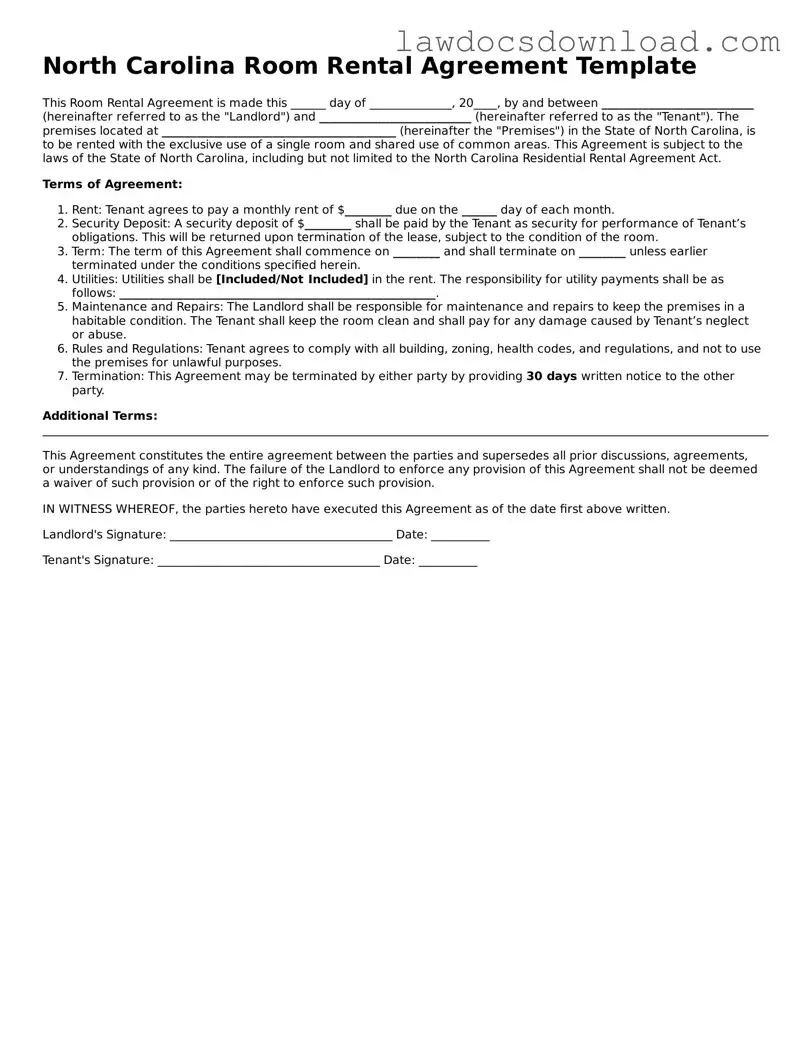A Room Rental Agreement in North Carolina shares similarities with a Lease Agreement, primarily because both establish a legally binding relationship between a property owner and a tenant. While the Room Rental Agreement typically pertains to a single room within a property, a Lease Agreement generally encompasses the rental of an entire apartment or house. Each document outlines the terms of the tenancy, duration of the rental period, payment schedule, and responsibilities of both parties, albeit at different scales of property rental.
Similar to the Roommate Agreement, the Room Rental Agreement also delineates the specifics of living arrangements among individuals sharing a common living space. However, a Roommate Agreement often dives deeper into the day-to-day aspects of shared living, such as chores, rules for guests, and how utilities are split. Both documents aim to minimize conflicts by setting clear expectations, but the Roommate Agreement focuses more on interpersonal relationships rather than the formal landlord-tenant dynamic.
A Sublease Agreement is another document similar to the Room Rental Agreement, as it involves renting out an already leased property. The key difference is that a Sublease Agreement is used when the original tenant wants to rent out the entire property or a portion of it to another tenant. It requires the landlord's approval and must adhere to the terms of the original lease. In contrast, a Room Rental Agreement is usually directly between the landlord and the individual renting the room.
The Property Management Agreement shares a connection with a Room Rental Agreement in that it involves the rental of property, but from a management standpoint. This agreement is between the property owner and a property manager or management company, detailing responsibilities such as finding tenants, collecting rent, and maintaining the property. While it operates at a broader level, both documents are crucial for the smooth operation and administration of rental properties.
A Rental Application is a preliminary document to a Room Rental Agreement, used by landlords to screen potential tenants. Both serve essential roles in the rental process; the application collects applicant information for background and credit checks, leading to a safer and more informed tenant selection. Meanwhile, the Room Rental Agreement formalizes the rental relationship after the applicant is approved.
Tenant Rules and Policies can be considered an extension of a Room Rental Agreement. These rules are usually outlined within or attached to the agreement and specify what behaviors are permitted and prohibited on the property (e.g., no smoking, no pets). Both documents work together to ensure that tenants are aware of their obligations and the standards of conduct expected to maintain a harmonious living environment.
An Eviction Notice, while it may seem quite different, is related to the nature of the Room Rental Agreement. It is a document used by landlords to notify tenants of breaches in the rental agreement — such as non-payment of rent — and serves as a formal request for the tenant to rectify the issue or vacate the property. Both documents are governed by state laws that protect the rights of both the tenant and the landlord.
The Security Deposit Receipt is linked to the Room Rental Agreement as it acknowledges the receipt of funds from the tenant to the landlord as a security deposit, which is normally required at the start of a tenancy. This receipt serves as proof of transaction for both parties and ensures that the terms regarding the security deposit outlined in the Room Rental Agreement are upheld, such as conditions for its return at the end of the tenancy.
The Maintenance Request Form, while not a binding agreement, complements the Room Rental Agreement by allowing tenants to formally request repairs or maintenance for issues within their rented space. These forms ensure that landlords are promptly informed of property issues, which they are typically obligated to address under the Room Rental Agreement. It helps document the responsiveness and responsibility of the landlords towards maintaining the property's condition.
Finally, the Notice to Enter is a document that, while seemingly peripheral, plays a significant role in the landlord-tenant relationship established by a Room Rental Agreement. This notice is given by the landlord to the tenant to inform them of the intention to enter the rented room or property, adhering to legal requirements for notice and respecting tenant privacy. It reinforces the respect for boundaries and legal rights outlined within the structure of the Room Rental Agreement.
